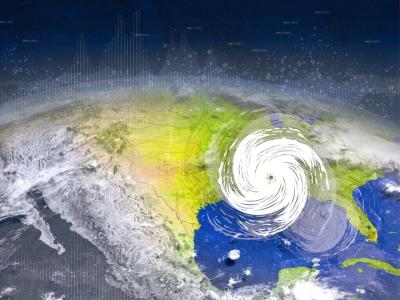Heightened U.S. Coastal Hurricane Risk Under Global Warming
Hurricanes are among the most destructive weather systems that annually affect U.S. coastal regions, making it important to understand how their associated risks may evolve under climate change. In this study, researchers addressed the problem using a hierarchical modeling framework. They showed that coastal hurricane frequency (CHF) will increase for the Gulf and lower East coasts with changes in steering flow, the large-scale winds that steer hurricane movements, playing the dominant role. Examining projected atmospheric circulation changes reveals that the development of new circulation near the Gulf of Mexico plays a decisive role in the steering flow changes. The changes that affect steering flow may also reduce vertical wind shear near the U.S. coast, providing a favorable environment for hurricane intensification.
Through a systematic and novel approach, researchers identified that the shifts in hurricane tracks governed by steering flow changes have more decisive impact on future coastal hurricanes than changes in hurricane intensity and translation speed. Previous studies suggested a likely reduction in coastal vertical wind shear but never provided a physical rationale for the changes until now. This study offers a mechanistic understanding for the projected decrease in wind shear near the U.S. coast for the first time. Combined with the identified steering flow changes, this work highlights the heightened risk of hurricanes affecting the U.S. coast under a warming climate.
Researchers combined output from 8 Coupled Model Intercomparison Project Phase 6 (CMIP6) models with RAFT (Risk Analysis Framework for Tropical Cyclones), a hybrid model developed at Pacific Northwest National Laboratory that generates large ensembles of hurricanes, to estimate future changes in coastal hurricane frequency (CHF). The analysis showed that CHF will likely increase for the Gulf and lower East coasts. The team decoupled the influence of intensity and steering flow changes by computing CHF projections based on the track model of RAFT alone, revealing the dominant influence of track shifts. An examination of circulation changes based on the CMIP6 models suggests that future hurricane steering flow will likely become more easterly near the Atlantic Coast and more southerly near the Gulf Coast, with upper-level winds playing a major role. To understand the cause of these circulation changes, experiments with a non-linear stationary wave model were performed. The experiments indicate that enhanced heating in the eastern tropical Pacific generates an anomalous atmospheric disturbance that pushes storms closer to the U.S. coast and increases CHF. The wind changes can also reduce vertical wind shear near the coast, thereby intensifying storms that approach this region and enhancing the potential for cyclone strengthening in the important nearshore region.

